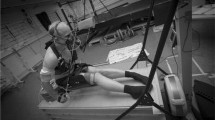Summary
Groups of top weight lifters, swimmers, runners and skiers were examined as regards functional capacity (maximal oxygen consumption measured during graded work load on a horizontal tread-mill), body build and composition (densitometry). Significant differences in mean ages (highest in skiers, lowest in swimmers) and body dimensions, attributable to natural selection, were found (highest length dimensions in swimmers, lowest in weight lifters). According to the specificity of training in individual disciplines studied, runners had lowest body weight and highest lean body mass proportion, and weight-lifters (who had highest relative weight) had lowest lean body mass proportion. Highest values of ventilation, breathing frequency, maximal oxygen consumption and oxygen pulse in skiers simultaneously with lowest pulse frequency were found; the reverse applies for weight lifters. Mutual relationships between somatic and functional characteristics in individual groups were evaluated.
Similar content being viewed by others
References
Åstrand, P. O.: Human physical fitness with special reference to sex and age. Physiol. Rev.36, 307–334 (1956).
Behnke, A. E., Royce, J.: Body size, shape and composition of several types of athletes. J. Sport Med. (Torino)6, 75–88 (1966).
Brožek, J. A., Hentschel, A., Keys, A.: Effect of submersion in water on the volume of residual air in men. J. appl. Physiol.5, 240 (1949).
Buskirk, E., Taylor, H. L.: Maximum oxygen intake and its relation to body composition, with special reference to chronic physical activity and obesity. J. appl. Physiol.11, 72–78 (1957).
Chtetsov, V. P., Lutovinova, N. Y., Utkina, M. I.: The morphological characteristics of some groups of sportsmen. VII. intern. Congr. Anthropol. Ethnol. Sci. Moscow 1964. Moscow: Nauka 1964.
Döbeln, W. v.: Human standard and maximal metabolic rate in relation to fat-free body mass. Acta physiol. scand. suppl.37, 126 (1956).
Ekblom, B., Åstrand, P. O., Saltin, B., Stenberg, J., Walström, B.: Effect of teaming on circulatory response to exercise. J. appl. Physiol.24, 518–528 (1968).
Lacour, J. R., Flandrois, R., Osman, H., Hebral, D., Danjou, M. A.: Étude comparative de la consommation maximale d'oxygène et de la masse maigre calculée par différentes méthodes. J. Physiol. (Paris)60, Suppl. 1, 268 (1968).
Macková, E.: Changes in functional and efficiency indicators between the 18th and 50th year in man. Physiol. bohemoslov.17, 279–287 (1968).
Magel, J. R., Faulkner, J. A.: Maximum oxygen uptake of college swimmers. J. appl. Physiol.22, 928–938 (1967).
Novák, L. P., Hyatt, R. E., Alexander, J. F.: Body composition and physiologic function in athletes. J. Amer. med. Ass.205, 764–770 (1968).
Pařízková, J.: Measurements of lean body mass development in adolescents by means of hydrostatic weighing method (in Czech.). Čs. Fysiol.8, 426 (1959).
—: Age trends in fat in normal and obese children. J. appl. Physiol.16, 173–174 (1961).
—: Changes of lean body mass and depot fat in gymnasts during periods of different intensity of training (in Russian). Teor. i. Prakt. fiz. Kult. Sport.25, 37 (1962).
—: The impact of age, diet and exercise on man's body composition. Ann. N. Y. Acad. Sci.110, 661 (1963).
Saltin, B., Åstrand, P. O.: Maximal oxygen uptake in athletes. J. appl. Physiol.23, 353–358 (1967).
Seliger, V., Dolejš, L., Karas, V., Pachlopníková, I.: Adaptation of trained athletes energy expenditure to repeated concentric and eccentric muscle contraction. Int. Z. angew. Physiol.26, 227–234 (1968).
Šprynarová, Š.: Maximum oxygen consumption during work-load on a treadmill. Physiol. bohemoslov.17, 383–393 (1969).
- Longitudinal study of the functional development in boys. (In press).
—: Pařízková, J.: Changes in the aerobic capacity and body composition in obese boys after reduction. J. appl. Physiol.20, 934–937 (1965).
— —: Comparison of the functional, circulatory and respiratory capacity in girl gymnasts and swimmers. J. Sport Med. (Torino)9, 165–172 (1969).
Welch, B. E., Riendeau, R. P., Crisp, C. E., Isenstein, R. I.: Relationship of maximal oxygen consumption to various components of body composition. J. appl. Physiol.12, 395–398 (1958).
Williams, C. C., Wyndham, C. H., Kok, R., Rahden, M. J. E. v.: Effect of training on maximum oxygen intake and on anaerobic metabolism in man. Int. Z. angew. Physiol.24, 18–23 (1967).
Wyndham, C. H., Heyns, A. J.: Determinants of oxygen consumption and maximal oxygen intake of Bantu and Caucasian males. Int. Z. angew. Physiol.27, 51–75 (1969).
Author information
Authors and Affiliations
Rights and permissions
About this article
Cite this article
Šprynarová, Š., Pařízková, J. Functional capacity and body composition in top weight-lifters, swimmers, runners and skiers. Int. Z. Angew. Physiol. Einschl. Arbeitsphysiol. 29, 184–194 (1971). https://doi.org/10.1007/BF00698026
Received:
Issue Date:
DOI: https://doi.org/10.1007/BF00698026




